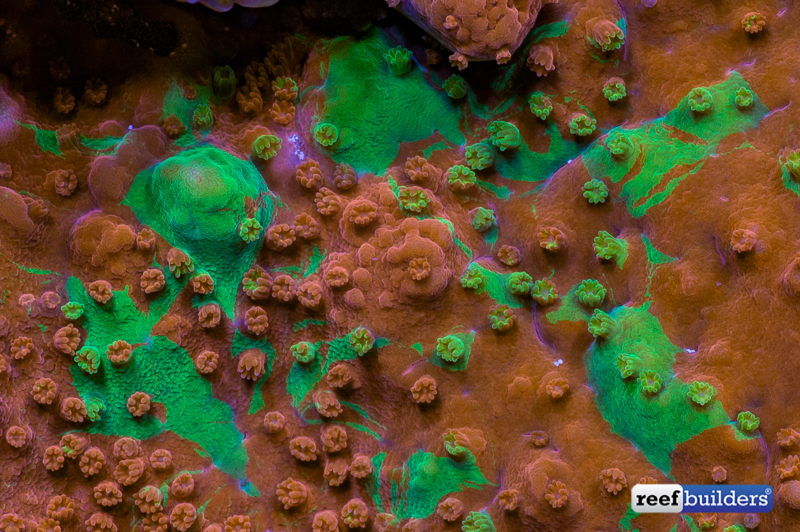The phenomenon of ‘GFP Infection’ in stony corals is documented well enough that reefers are actively looking for it, sometimes induce it, and we even ‘groom’ certain corals to train the colors to spread in a deliberate way. Many different corals have exhibited the GFP infection phenomenon over the years, but the most successful strain to spread through the aquarium hobby is definitely the World Wide Corals Grafted Cap.
GFP stands for Green Fluorescent Protein and it is part a large group of fluorescent proteins, including a wide range of green shades which are found all throughout the animal kingdom. Virtually all corals contain some degree of green fluorescent protein, and sometimes the GFP of one coral seems to ‘infect’ the tissue of another, with variable outcomes.

In some cases of GFP infection, the original green spot may remain static, persisting for weeks or months, even years. But in other cases, the site of green protein infection can spread and all but obscure the host coral’s original color. This is precisely the case with the original WWC Grafted Cap, a Montipora capricornis which was originally orange, but sometimes becomes overtaken by the green color of the foreign protein.


The plating growth form of the WWC Grafted cap is what has made it one of the most successful GFP-infected stony corals to propagate in the aquarium hobby. Plenty of other SPS Corals, particulary Montipora often show a GFP infection of their own, but encrusting species are much harder to manage the spread of GFP infections, with colonies and frags either becoming mostly taken over, or being outcompeted by the ‘native’ proteins of a given coral.

By now you may be asking yourself why the WWC Grafted Cap is referred to as grafted and this is because it was a name used to describe the phenomenon before we realized that there is no grafting of tissue, and that what these corals experience behaves more like an infection of pigments between two corals. We still do not know exactly what causes the transfer of fluorescent pigments from one coral to another, and we don’t believe there’s been any scientific investigation into it either.
Interestingly, the odd pattern of fluorescent pigments being found in aberrant ways is also seen in wild corals and plenty of species have demonstrated this in the wild. We’ve personally seen GFP infections in all manner of Acropora, Montipora, Stylocoeniella and several more. Thankfully, through the controlled environments of our mini reef aquariums we as reefers are at the frontlines of studying and documenting this interesting cross-pollination of fluorescent colors from one coral to another, and it’ll be really interesting to see what more we can learn about corals, fluorescence and the role of pigments in coral biology in the future.




